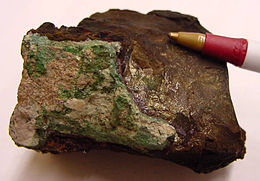
Malachite is a copper carbonate hydroxide mineral, with the formula Cu2CO3(OH)2. This opaque, green-banded mineral crystallizes in the monoclinic crystal system, and most often forms botryoidal, fibrous, or stalagmitic masses, in fractures and deep, underground spaces, where the water table and hydrothermal fluids provide the means for chemical precipitation. Individual crystals are rare, but occur as slender to acicular prisms. Pseudomorphs after more tabular or blocky azurite crystals also occur.

Bornite, also known as peacock ore, is a sulfide mineral with chemical composition Cu5FeS4 that crystallizes in the orthorhombic system (pseudo-cubic).
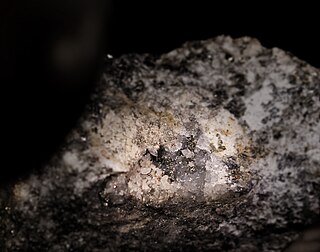
The mineral petzite, Ag3AuTe2, is a soft, steel-gray telluride mineral generally deposited by hydrothermal activity. It forms isometric crystals, and is usually associated with rare tellurium and gold minerals, often with silver, mercury, and copper.
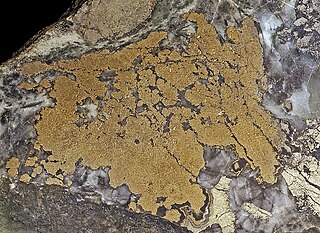
Nickeline or niccolite is a mineral consisting primarily of nickel arsenide (NiAs). The naturally-occurring mineral contains roughly 43.9% nickel and 56.1% arsenic by mass, but composition of the mineral may vary slightly.

Aurichalcite is a carbonate mineral, usually found as a secondary mineral in copper and zinc deposits. Its chemical formula is (Zn,Cu)5(CO3)2(OH)6. The zinc to copper ratio is about 5:4. Copper (Cu2+) gives aurichalcite its green-blue colors.

Chrysocolla ( KRIS-ə-KOL-ə) is a hydrous copper phyllosilicate mineral and mineraloid with the formula Cu
2 – xAl
x(H
2Si
2O
5)(OH)
4⋅nH
2O (x < 1) or (Cu, Al)
2H
2Si
2O
5(OH)
4⋅nH
2O).

Adamite is a zinc arsenate hydroxide mineral, Zn2AsO4OH. It is a mineral that typically occurs in the oxidized or weathered zone above zinc ore occurrences. Pure adamite is colorless, but usually it possess yellow color due to Fe compounds admixture. Tints of green also occur and are connected with copper substitutions in the mineral structure. Olivenite is a copper arsenate that is isostructural with adamite and there is considerable substitution between zinc and copper resulting in an intermediate called cuproadamite. Zincolivenite is a recently discovered mineral being an intermediate mineral with formula CuZn(AsO4)(OH). Manganese, cobalt, and nickel also substitute in the structure. An analogous zinc phosphate, tarbuttite, is known.

Crookesite is a selenide mineral composed of copper and selenium with variable thallium and silver.

Caledonite, whose name derives from Caledonia, the historical name of its place of discovery (Scotland), is a richly colored blue-green sulfate-carbonate mineral of lead and copper with an orthorhombic crystal structure. It is an uncommon mineral found in the oxidized zones of copper-lead deposits.
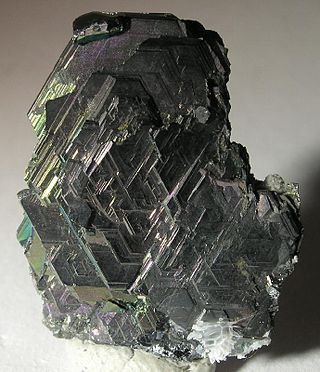
Polybasite is a sulfosalt mineral of silver, copper, antimony and arsenic. Its chemical formula is [(Ag,Cu)6(Sb,As)2S7][Ag9CuS4].

Rammelsbergite is a nickel arsenide mineral with formula NiAs2. It forms metallic silvery to tin white to reddish orthorhombic prismatic crystals, and is usually massive in form. It has a Mohs hardness of 5.5 and a specific gravity of 7.1.
Geigerite is a mineral, a complex hydrous manganese arsenate with formula: Mn5(AsO3OH)2(AsO4)2·10H2O. It forms triclinic pinacoidal, vitreous, colorless to red to brown crystals. It has a Mohs hardness of 3 and a specific gravity of 3.05.

Shattuckite is a copper silicate hydroxide mineral with formula Cu5(SiO3)4(OH)2. It crystallizes in the orthorhombic – dipyramidal crystal system and usually occurs in a granular massive form and also as fibrous acicular crystals. It is closely allied to plancheite in structure and appearance.
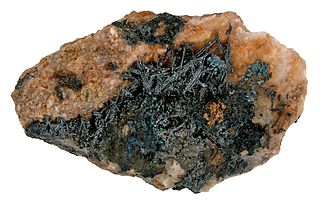
Stromeyerite or copper-silver glance is a sulfide mineral of copper and silver, with the chemical formula AgCuS. It forms opaque blue grey to dark blue orthorhombic crystals.
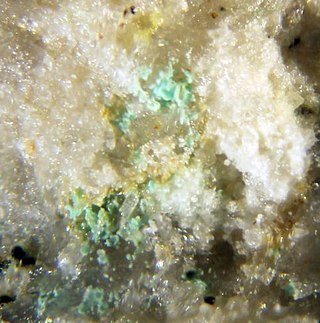
Cesbronite is a copper-tellurium oxysalt mineral with the chemical formula Cu3Te6+O4(OH)4 (IMA 17-C). It is colored green and its crystals are orthorhombic dipyramidal. Cesbronite is rated 3 on the Mohs Scale. It is named after Fabien Cesbron (born 1938), a French mineralogist.

Howlite, a calcium borosilicate hydroxide (Ca2B5SiO9(OH)5), is a borate mineral found in evaporite deposits.
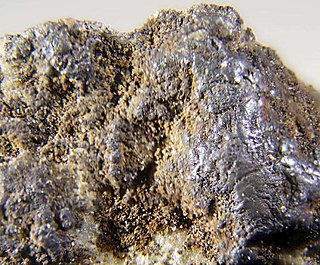
Kamiokite is an iron-molybdenum oxide mineral with the chemical formula Fe2Mo3O8. The name kamiokite is derived from the locality, the Kamioka mine in Gifu Prefecture, Japan, where this mineral was first discovered in 1975.

Strashimirite is a rare monoclinic mineral containing arsenic, copper, hydrogen, and oxygen. It has the chemical formula Cu8(AsO4)4(OH)4·5(H2O).

Diaboleite is a blue-colored mineral with formula Pb2CuCl2(OH)4. It was discovered in England in 1923 and named diaboleite, from the Greek word διά and boleite, meaning "distinct from boleite". The mineral has since been found in a number of countries.
